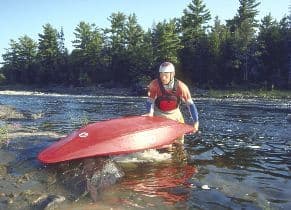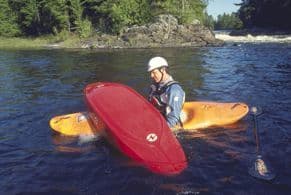Emptying a Whitewater Kayak
Emptying a swamped whitewater kayak is slightly different from emptying a swamped sea kayak because the boats are much smaller and more manageable, and because the shore is often much closer. Still, a little technique can make a big difference.
If someone in your group has gone for a swim, you have two choices: you can help them get to shore with their gear, or you can perform an on-water boat-over-boat rescue. Both of these options will be MUCH easier if there are float bags securely tied into the stern of the kayak.

In many cases, towing the person and their gear to shore is the best and easiest solution. On the banks of the river, the kayak can be emptied at a leisurely pace. The biggest challenge is often getting all the pieces to shore to begin with, especially when there is moving water to contend with, or if they're far away from shore. In this case, the swimmer will probably appreciate some help, either towing their gear, and/or themselves. As the swimmer, if you're close to the bank, leave the boat upside down (where it's full of air and thus lighter) and push it to shore. Now try to get one end up out of the water. Just by raising one end, water will have drained from at least half of the boat.
Take care in getting the end up on shore, especially if the boat is full, as it can be very heavy. If you have friends nearby, this may be a good time to call them forth! Now lift the lower end to dump the bulk of the water out through the cockpit. To drain the rest of the water, you can prop the centre of the boat up on your knee and rock it back and forth. Another helpful little gadget that many whitewater boats have, which sea kayaks don't, is a drain plug in the stern end. By unscrewing the drain plug and standing the boat up vertically, you can empty virtually all the water. Many whitewater paddlers (me included) like to carry a sponge in their boat to get the final drops out.
If a swimmer is far from shore and the water isn't too rough, the boat-over-boat rescue will be really hand, and it's very similar to the sea kayaing T-rescue. The boat-over-boat rescue involves dragging the upside down kayak over your own cockpit and rocking the boat back and forth to dump the majority of the water out. If the kayak has float bags in the stern, then it is easiest to do this by pulling the bow over your kayak first. Either way, it will certainly be useful to have the swimmer help push the boat across your kayak. Once the boat is empty, you can flip it upright and off your kayak. At this point you can either tow the boat to shore or provide the swimmer with an aided re-entry, just as you do for sea kayaking.

One of the great things about whitewater paddling is that you generally find yourself within easy reach of shore, and rapids usually end in calm pools that provide the perfect opportunity to gather the wreckage.
Related Articles
Even though they are flipping over, missing their gates and failing their maneuvers, they still look…
Last month we discussed how to detect and patch (not "repair") a leak on a typical roto-molded kayak…
A kayaker should have a number of recovery methods to choose from in their bag of skills. I feel the…
It is always good to have a few different ways to perform a capsize recovery. The main solo recovery…

